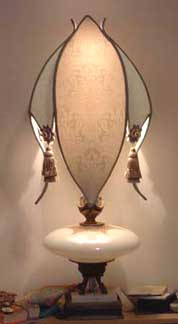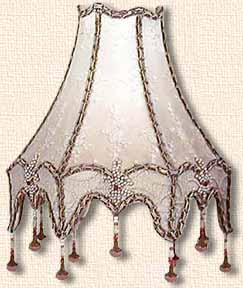|
|
|
Making "Victorian"/Panel Shades
What's included . . .
This section of Making Soft Lampshades offers step-by-step instructions for creating Victorian, Art Nouveau, Art Deco, and other panel-style shades, including how to make pleats, lace panels, and chiffon rosettes. Although this type of lampshade doesn't have a lining, in the traditional sense, they nonetheless look quite nice on the inside. Again, only beginner sewing skills are required, with everything you need to be able to sew well enough to accomplish this included in the text and Sewing Primer.
If you're among the many who think that using glue would make this easier, sewing is not only more appropriate, especially for use with silk and other fine fabrics, but it's actually faster, much longer lasting, and considerably less frustrating—thread isn't messy, doesn't stain, and is easily removed. However, the trim is often glued on (though it could be sewn), so you do still get to use glue. All the wonderful shades on this page were first-time projects, including Carol's, at the right side of the banner (see Testimonials for a larger version).
Excerpts from intro to Making "Victorian"/Panel Shades. . .
|
"Most people would have simply called this section Making Victorian-style Lampshades and been done with it. The problem is, everyone I asked about the history of this unique genre of lampshade told me that they're copied from a style popular during the teens, '20s, and on into the '30s, making them not the least bit Victorian."
|
 This 1924 advertisement shows these shades were in vogue long after the Victorian era ended in 1901. They're really Art Nouveau in design.
This 1924 advertisement shows these shades were in vogue long after the Victorian era ended in 1901. They're really Art Nouveau in design.
|
 Stephanie covered alternating panels with a gorgeous flowered fabric to create her spectacular first project.
Stephanie covered alternating panels with a gorgeous flowered fabric to create her spectacular first project.
|
"Whatever they're called, I think you're gonna be tickled pink at how easy they are to make (even if you've never sewn before). Although I'm doing a very simple version in this lesson, I cover everything you need to accomplish the most popular decorative techniques. Keep in mind, though, that the same method used to make Victorian-style shades can also be used to cover any free-standing frame."
|
|
"These lampshades can be a stunning accessory to far more decors than one might think. Believe it or not, an excellent (albeit obscure) example of their versatility is Maurice's living room on (the television program) Northern Exposure. It's a lodge style home, with exposed log beams and stone fireplace, and decorated with an eclectic mix of antiques, including Western and Native American. The lamps are all wearing gorgeous "Victorian"-style lampshades, and they fit in perfectly. So well, that you can't imagine what else could have been used, but most people would never have even considered such dressy lampshades with this decor."
|
 Cynthia's unique and elegant lampshade would look amazing amidst almost any decor.
Cynthia's unique and elegant lampshade would look amazing amidst almost any decor.
|
 Rina decorated this lovely, lace-covered shade with single strands of beads, which works perfectly with this frame, as do the tassels on the shades above.
Rina decorated this lovely, lace-covered shade with single strands of beads, which works perfectly with this frame, as do the tassels on the shades above.
|
"However, if you find these types of shades a bit fancy for your taste in decorating, remember that these frames can be covered in other ways. Use a nursery print for a baby's room, denim for a teenager, cover it with calico to give it a country look, or bark cloth to fit in with a mid-twentieth-century decor. You don't have to use fringe, some frames look fine without it, and anything that hangs below the bottom edge will work (including ruffles, lace, and crocheted edging). There's a salmagundi of possibilities, both for period reproductions, and all other styles of frames."
|
|
|

















